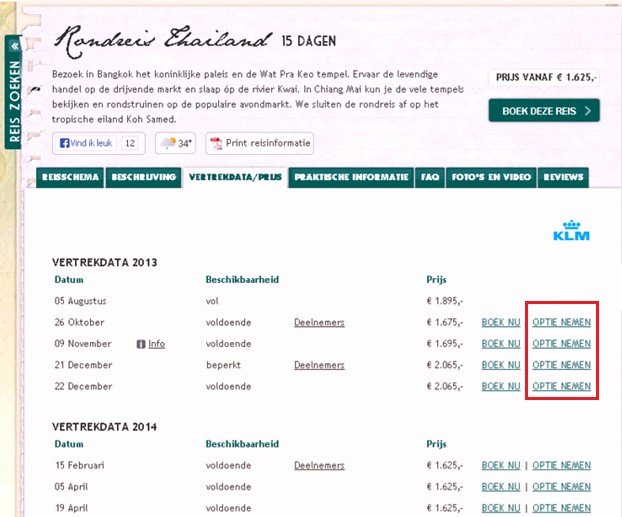How Djoser’s Focus on User Convenience Increased Their Online Travel Bookings
About Djoser
This success story draws on the one originally written by Thijs van der Wal, Conversion Rate Optimization Consultant at Traffic4u, an online marketing agency that uses VWO to optimize websites for its clients. The original success story won the Gold Award at WhichTestWon’s Online Testing Awards 2014.
Djoser, a major Dutch travel agency, hired Traffic4u to optimize its website conversions.
Goals: Increase Online Bookings
The Traffic4u team worked closely with Djoser to look for ways to increase the number of online bookings through Djoser’s website.
Tests run: Give users a greater sense of control over their decisions with a “take an option” CTA
In the original version (control), a text link with a call to action button Book now was placed next to the specific travel date. On the basis of data analysis and experience, the team concluded that making an actual booking was a significant step for users of Djoser. They hypothesized that giving users an option and greater flexibility to confirm their booking (rather than just either book or leave) might encourage more users to book.
To test the hypothesis, the team developed a variation that contained an extra link called Take an option. Clicking this link opened the same booking form and captured the same information, but tickets were not booked immediately. The new CTA allowed users to reserve spots on a tour, with the option to cancel within 72 hours, without incurring any charges. At the end of 72 hours, the reserved spot would automatically convert into a confirmed booking.
This option clearly communicated the relevant information through the booking form and the confirmation email. Prospective customers could cancel their reservations within 72 hours either by phone or email, without being charged anything.
The test was implemented on all travel details pages of Djoser.nl and focused on the travel data/price table. From this table, visitors continued to a booking form to book a specific trip.
This is what the variation with the Take an option CTA looked like:

Conclusion: 33% increase in bookings (including “take an option”)
Over the test period of 7 weeks, the variation resulted in 33.1% increase in bookings. The result had a 99% confidence level and was thus statistically significant. Given that visitors could also cancel through phone or email, backend data on cancellations was considered. The limited number of cancellations did not significantly influence the test results.
So why did this option result in additional bookings?
The answer in short is that it gave visitors time to mull over their decision, without any financial risk/penalty. At the same time, they knew they had a secure reservation if they decided to go ahead. And because they had already provided personal details and preferences, visitors had (unconsciously) entered into a relationship with Djoser.
This test also underscores that even relatively minor changes to a website can lead to significant improvements in conversions. While not all tests will lead to a positive result, every test will lead to insights.
But as a business owner or marketing agency, it is important that testing opportunities be regularly identified so that optimization opportunities are not missed or delayed.
The advice for advertisers is to design a continuous conversion optimization process. This process must comprise the following steps:
- Continually evaluate the effectiveness of your website on the basis of website statistics as well as user feedback.
- Create hypotheses and A/B tests on the basis of impact/effort ratio.
- Build and conduct tests.
- Document test results and then implement winning test variations.

Location
Netherlands
Industry
Travel
Experiment goals
Increase in number of bookings
Impact
33% increase in Conversion













